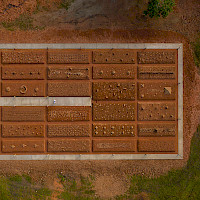Are We Contemporary?
Of course, there is no time zone encompassing the whole globe. Nevertheless, the co-presence of various temporal backgrounds in frequent online meetings might suggest global synchronization. There is no doubt: If we meet, we do so at the same time. But do we actually share a temporal understanding of this moment?
Discussing histories and futures of diverse cultures, raises questions on their compatibility in time. On what kind of temporal concepts are histories and futures based – from the perspectives of Hong Kong, Taipei, Kyoto, London, Zürich, or Singapore? Furthermore, the succession from histories to futures still seems to echo an imaginary thread of progress; a thread that has often been tied to modernity and modernization. Take the Shared Campus regions of East Asia and Western Europe for example; they are frequently discussed in clichés of an advanced (and technologically driven) Asia futurism and a (historically oriented) European modernity. Although we assume that there are many local histories and futures, we are used to communicate on the basis of one connected global present. Coming from temporalities in plural, do we finally meet in one present?
This theme group focus program aims at exploring temporal concepts in transcultural relations, opening a potential for revealing their complex preconditions, layers, or transformations. Leading questions include, but are not limited to: How could we translate between diverse temporal notions/temporal layers in the arts? To be contemporary in globalization: Does it imply a (certain form of) history or rather a continuous movement, a synchronized or coeval understanding of the present?
The following events are part of this programme:
- Kick-off workshop "Unlearning x Are we Contemporary?", 16 March 2023, 9-12:30 CET, online
- Workshop "Mapping, Loafing and Listening: Decolonial and subversive explorations of spaces, locations, con/temporalities and the Zoom dispositif", 23 June 2023, 9-12:30 CET, online
- Workshop "Gaps and Overlays: Dislocating Temporalities, online and on location" 29 September 2023, 9:00-12:30 CET, at ZHdK
- Public lecture and panel discussion "Are We Contemporary?", 29 September 2023, 18:30-20:30 CET at Kunsthaus Zürich(livestream available)
Contributors
Dr Michael ASBURY, University of Arts London/ Chelsea College of Arts
Mirjana DOKIC, City University of Hong Kong/ School of Creative Media
William DAVIS, Zurich University of the Arts/ Department of Fine Arts
Dr Alison GREEN, University of Arts London/ Central Saint Martins College of Arts and Design London
Per Magnus LINDBORG, City University of Hong Kong/ School of Creative Media
Dr Burkhard MELTZER, Zurich University of the Arts, Visual Communication
Dr Wolfgang MÜNCH, LASALLE College of the Arts Singapore
Daniel HUG, Zurich University of the Arts/ Department of Music
Yusaku IMAMURA, Tokyo University of the Arts
Proposed and coordinated by Dr Burkhard MELTZER
